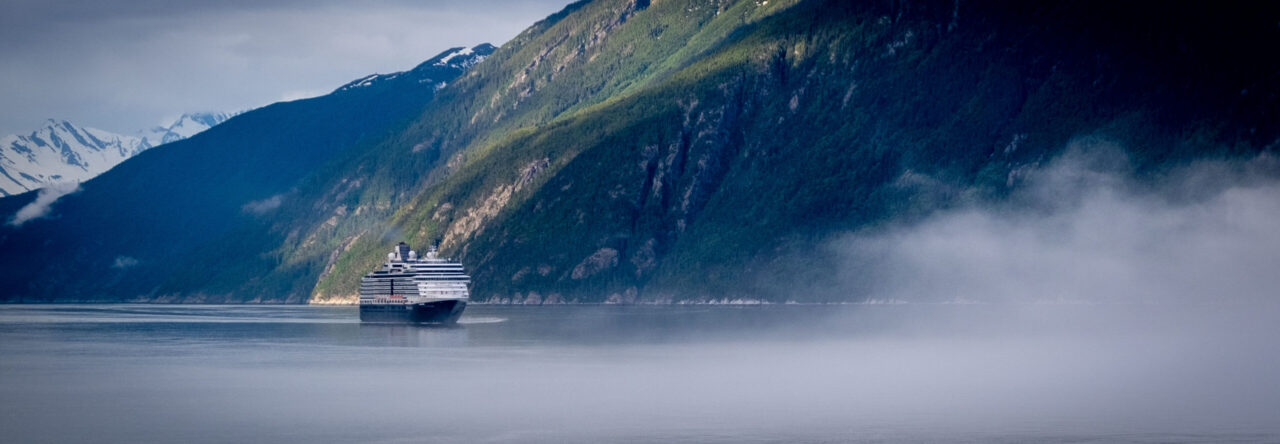Hurricane Ridge is the most easily accessible mountain region in Olympic National Park. It is an easy drive from Port Angeles to get to Hurricane Ridge. We looked at the weather when deciding to visit Hurricane Ridge as we wanted good views of the mountains, but as we discovered in Washington, the weather in one place does not have an impact on another area not that far away. It was sunny when we left Port Angeles but there were moments on Hurricane Ridge road that we could barely see in front of the car. The drive was a little nerve-wracking but luckily it cleared up when we got to the visitor center.
When researching Olympic National Park, we really wanted to do the trail to Hurricane Hill. The paved three-mile out-and-back trail has 700 foot elevation gain and is not for the faint of heart. Unfortunately, we were not able to make it all the way to the top because the last bit of the trail was still snow-covered. We were not prepared for snow hiking. If we had ice cleats and hiking poles we could’ve made it to the top, but regular hiking boots were not substantial enough. Just like at Going-to-the-Sun Road in Glacier, this Michigander did not expect to find snow on the ground in Washington in mid-June, but I have to remember that it is much colder in the mountains!
On our way back down, we had an animal encounter. Luckily, it was only a deer, but it got surprisingly close to us! This area is home to mountain goats and the trail is actually closed at the end of August for mountain goat management.
If you want to explore the mountains of Olympic National Park, Hurricane Ridge is the most convenient mountain section. If you want to ascent Hurricane Hill before the end of June, make sure you bring snow gear!
Thanks for stopping by! Next week I will be finishing my Olympic National Park recap, sharing about our experience in the Hoh Rainforest. To read more about this trip check out my Planes, Buses, and Boats Trip Report. To read about some of our previous trips, visit my Trips Page. If you like my photos be sure to “like” my Facebook Page and follow me on Instagram! You can purchase prints on Fine Art America. To see inside my camera bag, check out my updated Gear Page.
Pin This:





 We started our visit at a raptor talk where we met Owlison (left), a great horned owl, and Hannah, an avian care specialist. Owlison came to the Raptor Center with a fractured wrist bone and possibly some damage to her wing. Through Owlison’s rehabilitation, she is now capable of flight but not well enough to hunt on her own, so she is now a permanent resident at the Raptor Center.
We started our visit at a raptor talk where we met Owlison (left), a great horned owl, and Hannah, an avian care specialist. Owlison came to the Raptor Center with a fractured wrist bone and possibly some damage to her wing. Through Owlison’s rehabilitation, she is now capable of flight but not well enough to hunt on her own, so she is now a permanent resident at the Raptor Center. After the raptor talk, we got to see the Flight Training Center where rehabilitated birds are able to practice flying from perch to perch as they would do in the wild. Rehabilitators watch the birds in the training center to determine if they are able to fly well enough to survive in the wild and be released. When we visited the birds weren’t very active but it was very good to see the steps the experts at the Raptor Center take to make sure the birds will be able to survive on their own once they are well enough to leave the center.
After the raptor talk, we got to see the Flight Training Center where rehabilitated birds are able to practice flying from perch to perch as they would do in the wild. Rehabilitators watch the birds in the training center to determine if they are able to fly well enough to survive in the wild and be released. When we visited the birds weren’t very active but it was very good to see the steps the experts at the Raptor Center take to make sure the birds will be able to survive on their own once they are well enough to leave the center.

 Locating in northwestern North Dakota,
Locating in northwestern North Dakota, 



 From Fishing Bridge, we headed north to Canyon Village and one of my must-sees, Grand Canyon of the Yellowstone. There is a very large parking area in the canyon area and we had no trouble finding a spot to park. One of the best views of the falls can be found at the Artist Point trailhead (left). I love how even unedited photos of the waterfall look like a watercolor painting. This is one of the most popular areas to hike in the park with plenty of hiking trails for all abilities. For more information about hiking in Yellowstone, visit
From Fishing Bridge, we headed north to Canyon Village and one of my must-sees, Grand Canyon of the Yellowstone. There is a very large parking area in the canyon area and we had no trouble finding a spot to park. One of the best views of the falls can be found at the Artist Point trailhead (left). I love how even unedited photos of the waterfall look like a watercolor painting. This is one of the most popular areas to hike in the park with plenty of hiking trails for all abilities. For more information about hiking in Yellowstone, visit 



